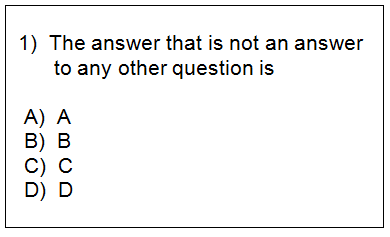Fun With Self-Referential Tests
 A few years ago, I stumbled upon James Propp’s Self-Referential Aptitude Test. I was immediately hooked, and spent hours navigating the interconnected logic puzzle that posed questions like “The answer to number 8 is ” and “The first question whose answer is C is “.
A few years ago, I stumbled upon James Propp’s Self-Referential Aptitude Test. I was immediately hooked, and spent hours navigating the interconnected logic puzzle that posed questions like “The answer to number 8 is ” and “The first question whose answer is C is “.
The experience was so challenging, frustrating, and ultimately rewarding, that it didn’t take long to realize it was a perfect exercise for students.
I ended up creating some simpler examples that gently introduce the student to the idea of a self-referential test, a test where questions and answers refer to other questions and answers. By playing around with these easier versions, students develop a sense of how to reason their way through using various problem-solving strategies.
After working through the more challenging versions, the final project for students is to create their own self-referential tests, which we then all enjoy solving. This is the perfect kind of project, in that it allows students to exercise their creativity while pondering substantial and significant mathematical questions like “What constitutes a solution to this test?” and “Are we sure that this puzzle has a solution?”, as well as fundamental mathematical ideas like logical consistency.
To get you started, I offer two simple versions of the test.
Five Question version: Simple Self-Referential Test 1
Ten Question version: Simple Self-Referential Test 2
Enjoy! And if you do, try making your own! It’s great fun, and a great student project. And keep in mind, questions like “Does this test have a solution?” and “Does this test have a unique solution?” are always interesting to consider.
And you can find James Propp’s original Self-Referential Aptitude Test here. Be warned: you might find it very frustrating!
1 Comment
Nikita Zolotykh · June 3, 2012 at 8:03 pm
I still think my and IL’s self-referential test was the best. Questions with the MC Escher drawing and the lines of symmetry in answer choices blew everyone’s minds.